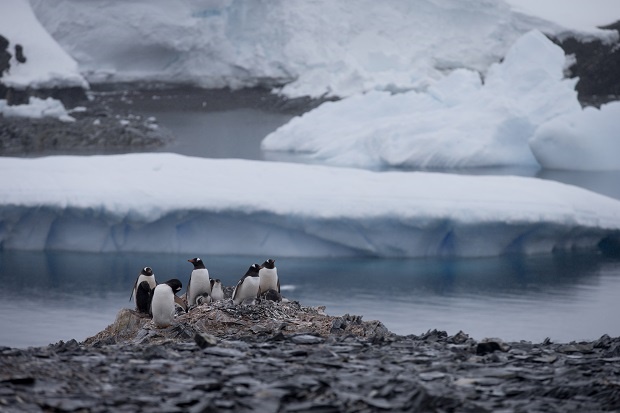Snow mounts in Antarctica but ice loss continues

In this Jan. 22, 2015 photo, Gentoo penguins stand on rocks near the Chilean station Bernardo O’Higgins, Antarctica. AP File Photo
MIAMI, United States—Annual snowfall has mounted 30 percent in West Antarctica over the past century, but the extra powder has not spelled good news for the melting ice sheet, researchers said Wednesday.
Instead, the snow is likely a result of heightened storm activity over warmer ocean waters, which are in turn leading to the ice loss, said the study in the journal Geophysical Research Letters.
“In this region, the same [storms] that have driven increased snowfall inland have brought warmer ocean currents into contact with West Antarctic’s ice shelves, resulting in rapid thinning,” said a statement by lead author Elizabeth Thomas, a paleoclimatologist with the British Antarctic Survey.
“Thus the increased snowfall we report here has not led to thickening of the ice sheet, but is in fact another symptom of the changes that are driving contemporary ice sheet loss.”
Using ice cores to examine snowfall as far back as 1712 along West Antarctica’s coast, researchers found a particularly rapid acceleration of snowfall since the 1990s.
Article continues after this advertisement“In the last 30 years of the study, the ice sheet gained nearly five meters (16 feet) more water than it did during the first 30 years of the studied time period.”
Article continues after this advertisementFrom 1900 to 2010, annual snow accumulation increased 30 percent, said the study.
Experts are closely watching the ice melt in Antarctica because the rapidly thinning ice sheet will play a key role in global sea level rise in the coming centuries.
Meanwhile, other studies have raised alarm bells that the melting, brought on by global warming and driven by the burning of fossil fuels, may have reached an irreversible point and will likely produce a three-meter rise in sea levels.
“Since the record is 300 years long, we can see that the amount of snow that has been accumulating in this region since the 1990s is the highest we have seen in the last 300 years,” said Thomas.
“The 20th century increases look unusual.”
The study said that until 1899, annual snow accumulation remained steady, averaging 33 and 40 centimeters (13 and 16 inches) of water, or melted snow, each year at two locations.
Researchers believe the recent rise in snow accumulation is due in part to increased regional storm activity and low pressure systems.
According to David Bromwich, a climate scientist at Ohio State University who was not involved in the study, a regional low-pressure system is likely one of several factors contributing to the increase in snowfall.
Other factors could include the evaporation of water brought on by ice loss in the region, he said.
RELATED STORIES
Antarctica: Mystery continent holds key to mankind’s future